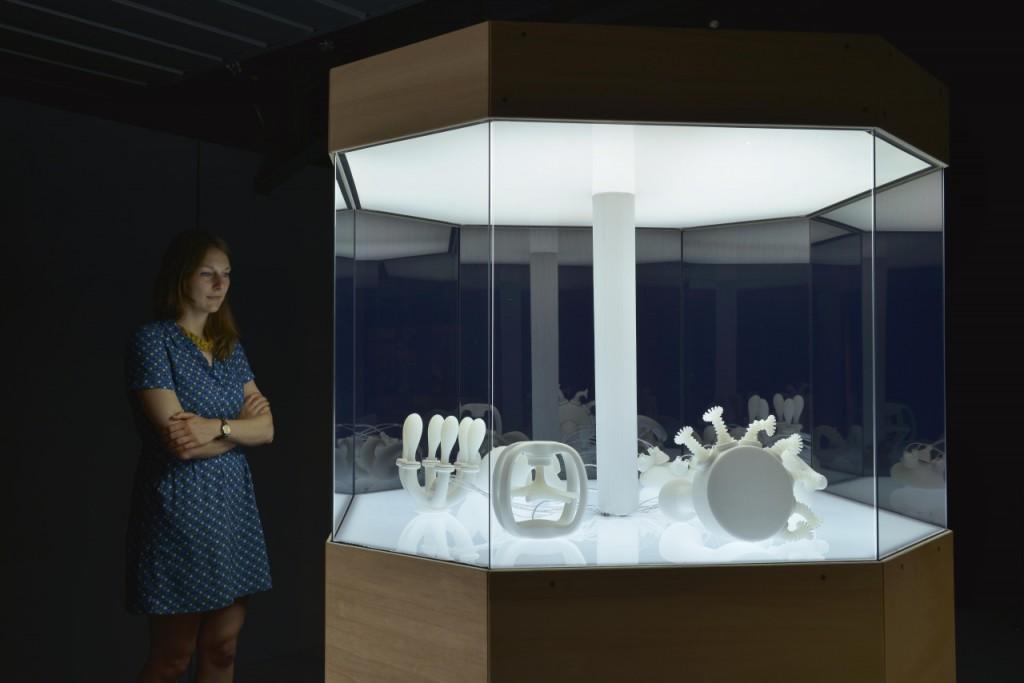Soft robotics is a relatively new field of research that aims to create flexible robots that are more easily adaptable to human interaction. Often, the forms of these creations and the mechanics of their movement are inspired by a close study of nature in an effort to ‘go organic’ with machines. 3D printing with flexible filament is one way in which this integration of robot and movement is taking on a flexible aspect.
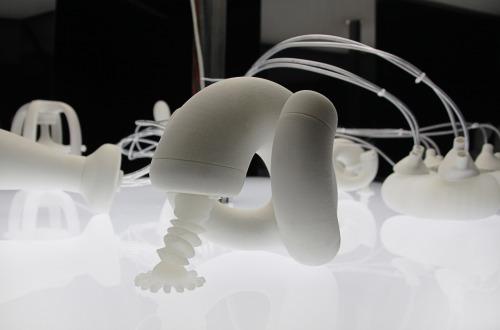 For this particular installation, titled Exo-biote, the National Institute for Research in Computer and Control and the Department of Science and Visual Culture at the Imaginarium worked together, with support from Neuflize Bank, to create a robot organism that embodied the formal typologies and demonstrated the possibilities for movements in soft robots. After all, some of nature’s most amazing machines have nearly entirely soft bodies – think of the octopus, for example, able to lift, carry, walk, swim, shape change, camouflage itself, and fit through a tube no bigger than a quarter!
For this particular installation, titled Exo-biote, the National Institute for Research in Computer and Control and the Department of Science and Visual Culture at the Imaginarium worked together, with support from Neuflize Bank, to create a robot organism that embodied the formal typologies and demonstrated the possibilities for movements in soft robots. After all, some of nature’s most amazing machines have nearly entirely soft bodies – think of the octopus, for example, able to lift, carry, walk, swim, shape change, camouflage itself, and fit through a tube no bigger than a quarter!
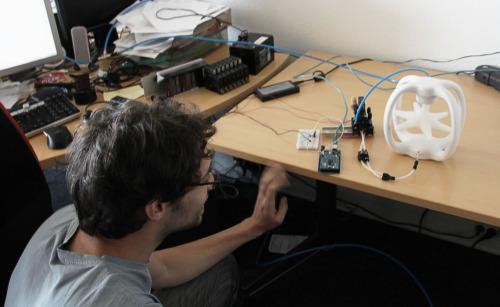 Understanding the most basic components available as the building set for soft robotics is a vital first step toward the creation of more complex soft machines. The idea behind this project was to use 3D printing to create a veritable ‘kit of parts’ that would provide the possible pieces by which something could be constructed; a series of soft robotics building blocks, if you will.
Understanding the most basic components available as the building set for soft robotics is a vital first step toward the creation of more complex soft machines. The idea behind this project was to use 3D printing to create a veritable ‘kit of parts’ that would provide the possible pieces by which something could be constructed; a series of soft robotics building blocks, if you will.
The exhibit created gives the impression of examining the internal organs of an albino dragon as large, sheet white objects pulse and flutter under glass.
The team working on the installation explained their experience of it: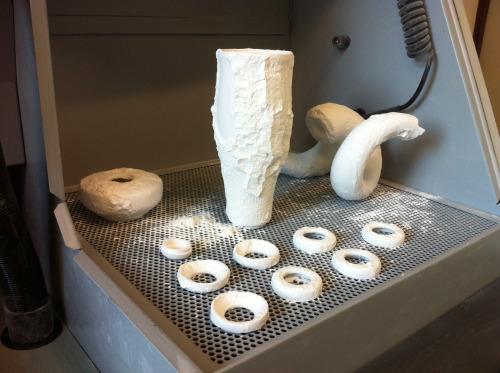
“These hybrid objects swell with air, they seem to live according to their own breath. These components are part of a whole, [they] belong to the same body whose moods can be observed by the beating of its organs. Spasmodic choreography draws the viewer into a journey wherein the objects appear as presented goods, ready-to-use products…mass produced organs.”
Ninety percent of the animal body is composed of soft or flexible material, this is one of living creatures’ strongest coping mechanisms. Rigidity is the only thing that can be broken and the state a body obtains when it is no longer able to modify itself in relation to its environment, it is the state known as part of death: rigor mortis.
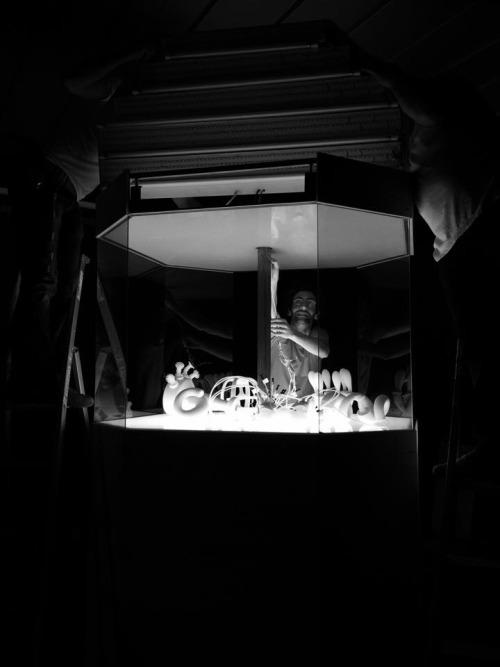 In the artist’s statement composed by creators Jonathan Pêpe and Julien Guillery, accompanying the exhibit, they describe the philosophical approach to the piece as well as raise questions about its meaning:
In the artist’s statement composed by creators Jonathan Pêpe and Julien Guillery, accompanying the exhibit, they describe the philosophical approach to the piece as well as raise questions about its meaning:
“As technology advances, the computer and the human body enter into an increasingly intimate relationship. In thinking about the future, this growing proximity between man and machine has led me to imagine their might be a structural change in computers. I hypothesize that the computer will become organic, become a living, flexible entity. The question remains: will this way of designing robotics take root in our time?”
The work is on display at the Fresnoy National Studio of Contemporary Arts as part of the exhibition Panorama 17. Let us know if you have the opportunity to visit in the Exo-biote forum thread over at 3DPB.com.
Subscribe to Our Email Newsletter
Stay up-to-date on all the latest news from the 3D printing industry and receive information and offers from third party vendors.
You May Also Like
Why Corrosive Resistant Materials Are Important to the Success of 3D Printing Across Industries
The adoption of additive manufacturing (AM) is accelerating across many major industries. As this technological shift unfolds, the importance of corrosion resistance has emerged as a challenge for 3D printing...
America Makes Announces IMPACT 2.0: $6.6M in New 3D Printing Funding
America Makes, the Manufacturing Innovation Institute (MII) based in Youngstown, Ohio, has announced IMPACT (Improvement in Manufacturing Productivity via Additive Capabilities and Techno-Economic Analysis) 2.0, a project call which will...
3D Printing Webinar and Event Roundup: April 14, 2024
We’re starting off the week’s 3D printing webinars and events at ASTM AMCOE’s 11th Snapshot Workshop and MACH Exhibition. Stratasys continues its advanced training courses, SME is holding a virtual...
AMUK Welcomes Airframe Designs as British 3D Printing Industry Grows
While the UK is not the hub for 3D printer and materials manufacturers as other nations, the country continues to excel at the research, development, and application of additive manufacturing...


